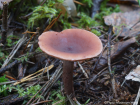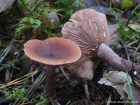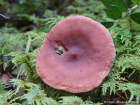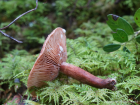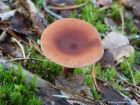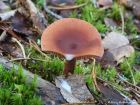Cap dark red-brown, becoming darker towards the centre. It is convex in shape, typically developing a central depression with a slight umbo, and has a furrowed margin. Gills pinkish cream to ochre, turning red-brown as they age, slightly decurrent, crowded, and release abundant mild-tasting latex. Stem pallid and similarly coloured as the cap, more or less equal, and finely downy and becoming hollow. The stem has no ring. Spore print white to cream-coloured.
Microscopic Features: The spores measure 7-8.5 x 6-7.5 µ and have a subglobose to broadly ellipsoid shape. They have ornamentation that consists of isolated warts and scattered ridges, which do not form consistent reticula and are 0.5-1.0 µ high.
Lactarius camphoratus on the First Nature Web site.
Lactarius camphoratus on the MushroomExpert.Com Web site.
Many mushrooms are poisonous, and some can be lethally toxic. Distinguishing between edible and poisonous mushrooms can be very challenging. Therefore, we strongly advise against consuming wild mushrooms. This website does not contain any information about the edibility or toxicity of mushrooms.
Although efforts have been made to ensure accuracy on this website, the information may contain errors and omissions. Therefore, all content provided is for educational and informational purposes only and should not be relied upon or used as a basis for consuming any plants or mushrooms.
External links are provided for reference only. We do not endorse or take responsibility for the content, advice, or products found on these sites or in any advertisements shown on this website.
